Sesamum trilobum
Sesamum trilobum (Bernh.) Byng & Christenh. (= Ceratotheca triloba (Bernh.) Hook.f.)
Family: Pedaliaceae
Common names: wild foxglove, African foxglove, false foxglove (Eng.); vingerhoedblom, wildevingerhoedjie (Afr.); ludvonca, udonqa (SiSwati); udonqa, undoncalwabathwa, udonqabathwa, udongalwezithutha (isiZulu); inkunzane enkulu (isiNdebele)
Introduction
Flowering during the warm summer and into autumn, this tall elegant annual adds a cool and lush feeling to the garden. In nature they are commonly found in the summer-rainfall areas of South Africa, especially the grasslands. Opportunistic annuals, they germinate best in disturbed areas like roadsides, where they manage to grow, flower and seed before the onset of the dry, frosty winter.

Description
Description
The wild foxglove varies in height, depending on the amount of water it receives during the summer. In the garden, with regular watering, they grow 1.5-2 m tall. Some plants become quite bushy while others remain single-stemmed. The soft, green leaves are about 50 mm long, divided into 3 lobes, with a bluntly serrated margin. The leaves are carried on long thin stalks up the stems. Plants with pink flowers usually have dark red stems while the white-flowering form have yellow-green stems. The leaves, stems and flowers are covered in fine white hairs. The plants are slightly sticky and when crushed give off a strong unpleasant smell. The flowers last for a few days in the vase.
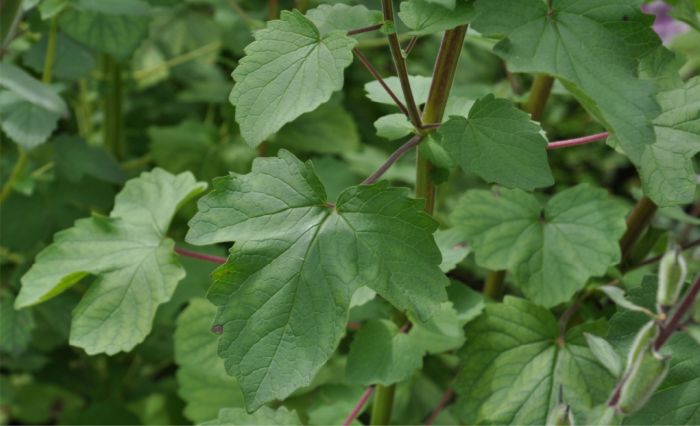
The beautiful white or mauve foxglove-like flowers are carried in pairs up the stems in tall, sparsely flowered spikes. Unfortunately the promise of an overwhelming display is never fulfilled as only two or three flowers on a stem open at a time. The bottom flowers open first and form fruits while new buds are still developing at the tip of the stem. Each flower is about 50 mm long with 5 lobes, the bottom lobe longer than the others and streaked with delicate lines running into the throat.
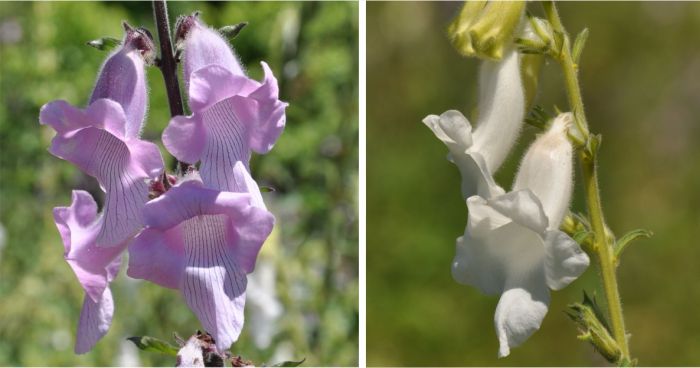
In nature the wild foxglove flowers throughout summer but at Kirstenbosch the best display is during the late summer months (Feb.-Mar.). The small black seeds are formed in the 30 mm long fruits which have two very prominent horns at their tips. Within a few weeks of flowering, the green fruits dry and turn brown, splitting open to release the flat, pear-shaped seeds.
Conservation Status
Status
Least Concern (LC). Sesamum trilobum is not threatened.
Distribution and habitat
Distribution description
The wild foxglove occurs in the provinces of Eastern Cape, Free State, Northern Cape, Gauteng, KwaZulu-Natal, Limpopo, Mpumalanga in northeastern South Africa, and in Eswatini, Mozambique, Zimbabwe and Botswana. It grows in grassland, often in disturbed places.
Derivation of name and historical aspects
History
This species was previously placed in the genus Ceratotheca, one of two species of Ceratotheca found in South Africa. The genus name Ceratotheca means ‘having horned capsules’, from the Greek kerato-, meaning ‘horned’ and theke, meaning ‘a case’. These horned fruits are what distinguished this genus. The species that were previously classified in Ceratotheca are now considered to be genetically and morphologically indistinct from plants in the genus Sesamum and all species have thus been transferred. The genus name Sesamum is the Greek and Latin name for sesame, Sesamum indicum. The specific epithet trilobum means ‘three-lobed’ (Latin), alluding to the leaves.
Although given the common name of wild foxglove, this is based on a superficial resemblance only, and it is not a kind of foxglove of the genus Digitalis in the family Plantaginaceae. The wild foxglove belongs in the sesame family, Pedaliaceae.
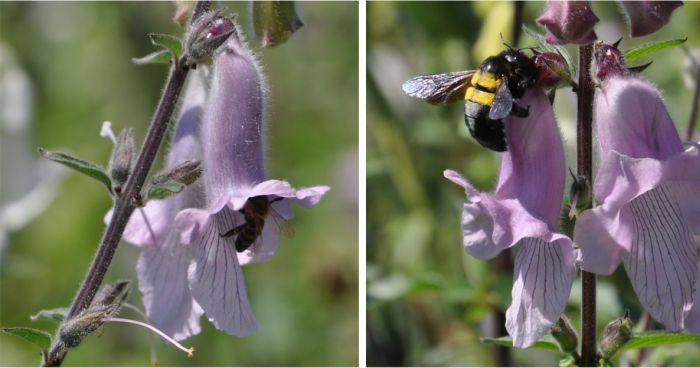
Ecology
Ecology
When in flower, Sesamum trilobum creates quite a buzz as a favourite of the carpenter bees and honeybees. A closer look shows that honeybees are the pollinators because they crawl inside the flowers to feed on the nectar and while doing so, touch the anthers and stigma, whereas the larger carpenter bees do not crawl inside, but bite a hole through the flower, bypassing the pollen and stigma and ‘stealing’ nectar.
Wild foxglove is an opportunistic annual or biennial herb. When conditions are favourable, it germinates, grow fast, flowers and sets seed in a short period of time, and survives unfavourable conditions as seed.
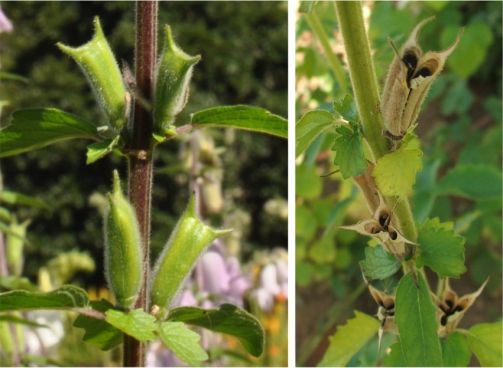
Uses
Use
Sesamum trilobum leaves are used in traditional medicine to treat painful menstruation, stomach cramps, nausea, fever and diarrhoea. Roots are used to treat sore eyes and ears. Leaves can be used in sprays to repel insects. Leaves are also cooked and eaten as spinach, or as a relish, the unpleasant scent disappearing with boiling. However, recent studies show it to have good nutritional potential, containing fat, proteins and carbohydrate, but it also has slight toxicity at high concentrations.
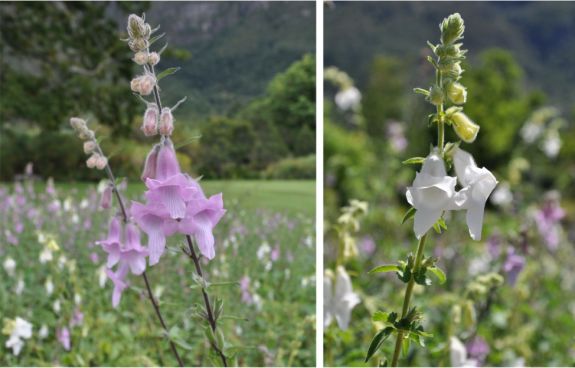
Growing Sesamum trilobum
Grow
In the garden these annuals prefer rich, well-drained soils in full sun or semi-shade. The wild foxglove can survive with very little water, but to grow tall and lush, they need plenty of water throughout the summer. For the best display, plant them close together in large groups. They will seed themselves freely if left to go to seed.
Propagate the wild foxglove by seed sown in spring or early summer (Sep.–Nov.). Sow the seed evenly and not too thickly, in seed trays filled with a well-drained medium. Cover the seeds with a thin layer of white sand or fine milled bark, water well and place the tray in light shade. Germination is usually very good, but the young seedlings are often a bit slow to grow initially. They respond very well to feeding with organic fertiliser like Seagro or Humac as an initial boost. The seedlings can be planted into the garden as soon as they are big enough to handle, usually about 6-8 weeks after sowing.
References
- Christenhusz, M.J.M., Fay, M.F.F. & Byng, J.W. 2018. The Global Flora. A practical flora to vascular plant species of the world. Special edition. GLOVAP Nomenclature Part 1. Plant Gateway, Bradford.
- Hutchings, A., Scott, A.H., Lewis, G. & Cunningham, A.B. 1996. Zulu medicinal plants: an inventory. University of Natal Press, Pietermaritzburg.
- Jackson, W.P.U. 1990. Origins and meanings of names of South African plant genera. University of Cape Town.
- Masondo, N.A., Finnie, J.F. & Van Staden, J. 2016. Nutritional and pharmacological potential of the genus Ceratotheca – an underutilized leafy vegetable of Africa. Journal of Ethnopharmacology 178:209-221. DOI: 10.1016/j.jep.2015.12.003.
- Mudzwiri, M. 2007. Evaluation of traditional South African leafy plants for their safety in human consumption . M.Tech Thesis. University of Technology, Durban.
- Plants of the World Online, Sesamum trilobum (Bernh.) Byng & Christenh. Sesamum L. https://powo.science.kew.org/taxon/urn:lsid:ipni.org:names:77183916-1. Accessed 204/9/23.
- Pooley, E. 2005. A field guide to wild flowers KwaZulu-Natal and the eastern regions. The Flora Publications Trust, Durban.
- Raimondo, D., Von Staden, L., Foden, W., Victor, J.E., Helme, N.A., Turner, R.C., Kamundi, D.A. & Manyama, P.A. (eds) 2009. Red list of South African plants. Strelitzia 25. South African National Biodiversity Institute, Pretoria.
- Roberts, M. 1990. Indigenous healing plants. Southern Book Publishers, Halfway House, Johannesburg.
Credits
Liesl van der Walt
Kirstenbosch National Botanical Garden
February 2001
Updated by Alice Notten
Kirstenbosch National Botanical Garden
September 2023
Plant Attributes:
Plant Type: Bi/Annual
SA Distribution: Eastern Cape, Free State, Gauteng, KwaZulu-Natal, Limpopo, Mpumalanga, Northern Cape
Soil type: Sandy, Loam
Flowering season: Early Summer, Late Summer, Autumn
PH: Acid, Alkaline, Neutral
Flower colour: White, Mauve/Lilac
Aspect: Full Sun, Morning Sun (Semi Shade), Afternoon Sun (Semi Shade)
Gardening skill: Easy
Special Features:
Horticultural zones










Rate this article
Article well written and informative
Rate this plant
Is this an interesting plant?
Login to add your Comment
Back to topNot registered yet? Click here to register.